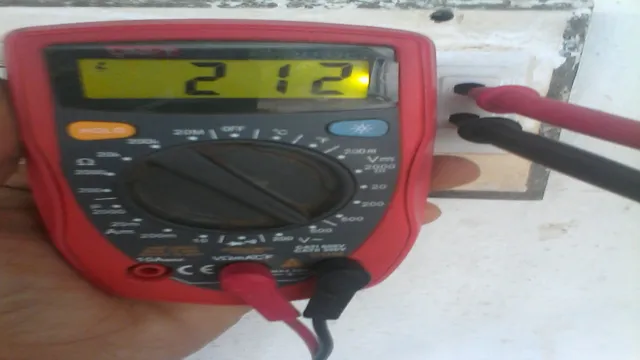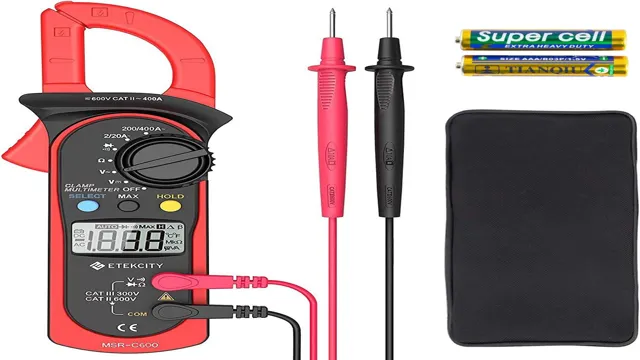Have you ever wondered if your voltage tester is giving you an accurate reading? It’s important to know how to test your voltage tester to ensure your safety when working with electrical systems. A faulty voltage tester can lead to incorrect measurements and potentially dangerous situations. In this blog, we’ll guide you through the steps to test your voltage tester and give you peace of mind when working with electricity.
Think of it as a check-up for your trusty tool – it’s always better to be safe than sorry. So let’s dive in and make sure your voltage tester is up to par.
Introduction
If you’re using a voltage tester, it’s crucial to ensure that it’s working correctly. Testing your voltage tester may seem complicated, but it’s essential to ensure that the tool is safe and accurate. The first step is to check the battery’s power and ensure that it’s working correctly.
Next, test the voltage tester by plugging it into a known power source or appliance to check if it’s detecting the voltage correctly. If you’re still unsure, you can double-check using another testing tool or take it to a professional for calibration or testing. It’s critical to do this regularly, especially if you’re using your voltage tester for electrical work or handling potentially dangerous situations.
Don’t risk your safety or others’ safety by using an unreliable voltage tester.
What is a Voltage Tester
A voltage tester is an essential tool for anyone who works with electrical wiring and appliances. It is used to check the electrical flow and voltage levels in a circuit, ensuring that it is safe to work with. Voltage testers are handheld devices that are easy to use and come in a variety of shapes and sizes.
They typically have two probes or leads that are inserted into an electrical outlet or wire, and the device displays the voltage reading on a digital or analog display. The voltage tester is particularly useful for troubleshooting electrical problems and is a necessary tool for both professional electricians and DIY enthusiasts. Using a voltage tester can help prevent accidents and injuries by identifying potential electrical hazards before they can cause damage.
Whether you’re repairing a broken circuit or simply need to check the voltage of an appliance, a voltage tester is an essential tool that every homeowner and electrician should own.

Why Test Your Voltage Tester
Voltage Tester Introduction: A voltage tester has become an essential tool for electricians and DIY enthusiasts. Whether you’re replacing a switch or adding a new outlet in your home, a voltage tester is an essential tool that can quickly detect the presence of live electricity in a wire, outlet or appliance. But, have you ever thought about testing your voltage tester? Yes, you read that right! Testing your voltage tester is essential to ensure its accuracy and safety.
In this article, we will delve into the reasons why testing your voltage tester is crucial. So, buckle up and let’s get started!
Testing Your Voltage Tester
If you rely on a voltage tester for your work, it’s essential to know that it’s accurate and reliable. Testing your voltage tester is key to ensure it’s functioning correctly and providing accurate readings. One simple way to test your voltage tester is to use a known source, such as a battery.
Start by testing the battery with a trusted voltage meter, then use your voltage tester on the same battery. If your tester gives you the same reading as the reliable voltage meter, then it’s accurate. If it doesn’t match, then you may need to calibrate your tester or replace it.
Another method is to use a voltage reference, a calibration device that outputs a precise voltage value. Testing your voltage tester with a voltage reference is a more precise method than using a battery. It’s essential to test your tester regularly to avoid any misidentifications or mistakes, and to ensure that you’re working safely.
Remember that a voltage tester is a crucial tool in your kit, and hence it’s essential to ensure it’s functioning correctly.
Checking for Voltage
When it comes to electrical work, safety should always be a top priority. Testing your voltage tester is a crucial step to ensure that you’re using the right equipment and giving yourself the best chance of staying safe. You might think that your tester is working correctly, but it’s always better to confirm this before starting any project.
One way to test your voltage tester is by using a known power source, such as a wall outlet, while another is by using a voltage reference. A voltage reference is a device that provides a specific voltage reading that you can compare to the reading on your tester. This will give you an idea of how accurate your tester is and whether it needs to be recalibrated.
Testing your voltage tester might seem like a minor step, but it can make a major difference when working with electricity. So, always be sure to check your equipment before starting any electrical project.
Testing Voltage Accuracy
Testing voltage accuracy is an essential step in ensuring the safety of your electrical wiring and appliances. A voltage tester is a handy tool that detects the presence of electrical voltage in a circuit. However, like any other testing equipment, a voltage tester can lose its accuracy over time and use.
To ensure that your voltage tester is accurate, you can perform a simple test using a known voltage source. First, ensure that the voltage source is rated within the range of your voltage tester. Then, connect the voltage source to the tester and compare the readings with the actual voltage using a multimeter.
If the readings are within an acceptable margin of error, your voltage tester is accurate and ready to use. Regular testing of your voltage tester can prevent misreadings and ensure that your electrical systems are in good condition.
Testing Continuity
Testing continuity is a crucial step in electrical work. It ensures that the current can flow smoothly through the circuit, preventing any glitches. One of the tools frequently used for this task is a voltage tester.
It is essential to ensure that the voltage tester is working correctly before commencing the continuity test. To check the tester’s accuracy, you can use a voltage source of known voltage, such as a battery, and test the voltage tester’s output. If the voltage tester shows the same voltage as the battery, it is working correctly.
Additionally, don’t forget to check the tester’s battery regularly, as a weak battery can mislead the continuity test result. Once your voltage tester is confirmed to be functioning correctly, you can move forward with the continuity test with confidence.
Safety Precautions
Ensuring safety when handling electricity is crucial, and one way to do that is by using a voltage tester. But how can you be sure your voltage tester is working efficiently? Here are some steps on how to test a voltage tester. First, test the device with a known live circuit to make sure it is working correctly.
Next, check the batteries to ensure that they are in good condition and have enough power. If the tester uses test leads, verify their insulation integrity and make sure they’re undamaged. Finally, conduct a self-test on the tester itself by using it to detect voltage on a known live circuit and then verify that the tester indicates voltage by observing the test light, display, or both.
Following these simple steps can help you make sure your voltage tester is working correctly and keep you, and those around you safe. Remember, always double-check and follow all safety precautions when working with electricity.
Turning Off Power
When it comes to working on electrical systems, one of the most important safety precautions is to always turn off the power. Whether you’re fixing a light fixture or installing a new outlet, you need to make sure the power is off before you begin. This may seem like common sense, but it’s easy to forget in the heat of the moment.
One way to ensure you don’t forget is to make a habit of switching off the breaker or pulling the fuse before you start any electrical work. This can prevent electrocution and protect you from a potentially dangerous situation. Remember, safety should always be the top priority when working with electricity, and turning off the power is a simple yet crucial step to take.
Wearing Protective Gear
Wearing protective gear is one of the most important safety precautions to take in any hazardous working environment. Whether you’re working in a construction site or handling chemicals, wearing protective gear can significantly reduce the risk of injuries and accidents. Helmets, safety boots, and gloves are just a few examples of essential safety equipment that can help keep you safe on the job.
Investing in good quality protective gear is a small price to pay in comparison to the potential consequences of not wearing them. Just like putting on a seatbelt before driving, putting on protective gear should always be your first step before commencing work. Remember, your safety is your responsibility, so take necessary steps to protect yourself and those around you.
Conclusion
In summary, testing a voltage tester is like testing the detective skills of Hercule Poirot – it requires precision, attention to detail, and a little bit of creativity. To ensure that your voltage tester is reliable and accurate, follow these steps: first, check the tester’s battery to ensure sufficient power. Then, find a known voltage source and test it with your tester, making sure to compare the reading to that of a known accurate device.
Finally, test the tester on various voltage sources to ensure consistency in readings. With these steps, you’ll be confident that your voltage tester is as reliable as the little grey cells of Poirot himself.”
FAQs
What is a voltage tester?
A voltage tester is an electronic device used to test the presence or absence of an electrical current in an electrical circuit.
How do you use a voltage tester?
To use a voltage tester, touch the tip of the device to a wire or outlet to test for the presence of an electrical current.
Can a voltage tester detect a live wire?
Yes, a voltage tester can detect a live wire. It is important to use caution when testing for live wires, and to follow proper safety procedures.
What are some safety precautions to take when using a voltage tester?
When using a voltage tester, be sure to wear appropriate protective gear, such as gloves and safety glasses, and to avoid contact with live wires. Always follow proper safety procedures and guidelines.
How accurate are voltage testers?
Voltage testers can vary in accuracy, depending on the specific device and its calibration. It is important to use a reliable and properly calibrated voltage tester for accurate readings.
Can a voltage tester be used to test the voltage of batteries?
Yes, a voltage tester can be used to test the voltage of batteries. However, it is important to use a voltage tester that is specifically designed for this purpose.
How often should you calibrate your voltage tester?
The frequency of calibration for a voltage tester can vary depending on the device and its use. It is generally recommended to calibrate your voltage tester on a regular basis, such as every 6 to 12 months.






